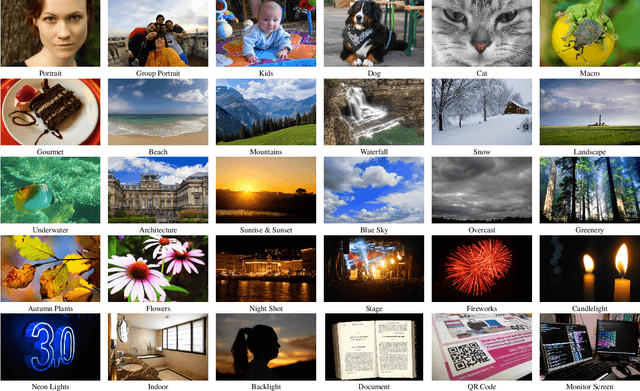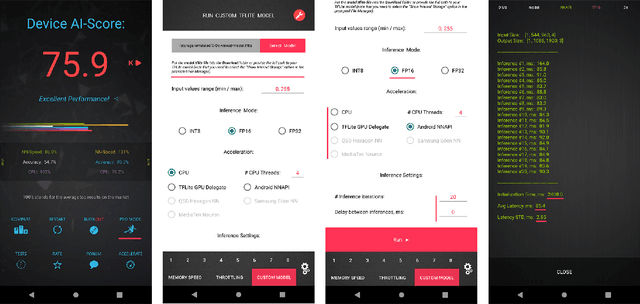Himanshu Kumar
NanoVLMs: How small can we go and still make coherent Vision Language Models?
Feb 11, 2025Abstract:Vision-Language Models (VLMs), such as GPT-4V and Llama 3.2 vision, have garnered significant research attention for their ability to leverage Large Language Models (LLMs) in multimodal tasks. However, their potential is constrained by inherent challenges, including proprietary restrictions, substantial computational demands, and limited accessibility. Smaller models, such as GIT and BLIP, exhibit marked limitations, often failing to generate coherent and consistent text beyond a few tokens, even with extensive training. This underscores a pivotal inquiry: how small can a VLM be and still produce fluent and consistent text? Drawing inspiration from the exceptional learning process of 3-4 year old children, who rely heavily on visual cues for understanding and communication, we introduce two novel datasets: ShortDesc (featuring concise image descriptions) and LongDesc (containing more detailed image descriptions). These datasets consist of image-text pairs where the text is restricted to the simple vocabulary and syntax typically used by young children, generated with a scaled- down model, GPT-4o. Using these datasets, we demonstrate that it is possible to train VLMs that are significantly smaller, up to 10 times smaller than state of the art(SOTA) small VLMs while maintaining architectural simplicity. To evaluate the outputs, we leverage GPT-4o to grade the text, as if stories written by students, on creativity, meaningfulness, and consistency, assigning scores out of 10. This method addresses limitations of standard benchmarks by accommodating unstructured outputs and providing a multidimensional evaluation of the model capabilities. Our findings contribute to the development of lightweight, accessible multimodal models for resource constrained environments.
3rd Workshop on Maritime Computer Vision (MaCVi) 2025: Challenge Results
Jan 17, 2025Abstract:The 3rd Workshop on Maritime Computer Vision (MaCVi) 2025 addresses maritime computer vision for Unmanned Surface Vehicles (USV) and underwater. This report offers a comprehensive overview of the findings from the challenges. We provide both statistical and qualitative analyses, evaluating trends from over 700 submissions. All datasets, evaluation code, and the leaderboard are available to the public at https://macvi.org/workshop/macvi25.
A Multimodal Dataset for Enhancing Industrial Task Monitoring and Engagement Prediction
Jan 10, 2025



Abstract:Detecting and interpreting operator actions, engagement, and object interactions in dynamic industrial workflows remains a significant challenge in human-robot collaboration research, especially within complex, real-world environments. Traditional unimodal methods often fall short of capturing the intricacies of these unstructured industrial settings. To address this gap, we present a novel Multimodal Industrial Activity Monitoring (MIAM) dataset that captures realistic assembly and disassembly tasks, facilitating the evaluation of key meta-tasks such as action localization, object interaction, and engagement prediction. The dataset comprises multi-view RGB, depth, and Inertial Measurement Unit (IMU) data collected from 22 sessions, amounting to 290 minutes of untrimmed video, annotated in detail for task performance and operator behavior. Its distinctiveness lies in the integration of multiple data modalities and its emphasis on real-world, untrimmed industrial workflows-key for advancing research in human-robot collaboration and operator monitoring. Additionally, we propose a multimodal network that fuses RGB frames, IMU data, and skeleton sequences to predict engagement levels during industrial tasks. Our approach improves the accuracy of recognizing engagement states, providing a robust solution for monitoring operator performance in dynamic industrial environments. The dataset and code can be accessed from https://github.com/navalkishoremehta95/MIAM/.
A Volumetric Saliency Guided Image Summarization for RGB-D Indoor Scene Classification
Jan 19, 2024Abstract:Image summary, an abridged version of the original visual content, can be used to represent the scene. Thus, tasks such as scene classification, identification, indexing, etc., can be performed efficiently using the unique summary. Saliency is the most commonly used technique for generating the relevant image summary. However, the definition of saliency is subjective in nature and depends upon the application. Existing saliency detection methods using RGB-D data mainly focus on color, texture, and depth features. Consequently, the generated summary contains either foreground objects or non-stationary objects. However, applications such as scene identification require stationary characteristics of the scene, unlike state-of-the-art methods. This paper proposes a novel volumetric saliency-guided framework for indoor scene classification. The results highlight the efficacy of the proposed method.
ParaColorizer: Realistic Image Colorization using Parallel Generative Networks
Aug 17, 2022



Abstract:Grayscale image colorization is a fascinating application of AI for information restoration. The inherently ill-posed nature of the problem makes it even more challenging since the outputs could be multi-modal. The learning-based methods currently in use produce acceptable results for straightforward cases but usually fail to restore the contextual information in the absence of clear figure-ground separation. Also, the images suffer from color bleeding and desaturated backgrounds since a single model trained on full image features is insufficient for learning the diverse data modes. To address these issues, we present a parallel GAN-based colorization framework. In our approach, each separately tailored GAN pipeline colorizes the foreground (using object-level features) or the background (using full-image features). The foreground pipeline employs a Residual-UNet with self-attention as its generator trained using the full-image features and the corresponding object-level features from the COCO dataset. The background pipeline relies on full-image features and additional training examples from the Places dataset. We design a DenseFuse-based fusion network to obtain the final colorized image by feature-based fusion of the parallelly generated outputs. We show the shortcomings of the non-perceptual evaluation metrics commonly used to assess multi-modal problems like image colorization and perform extensive performance evaluation of our framework using multiple perceptual metrics. Our approach outperforms most of the existing learning-based methods and produces results comparable to the state-of-the-art. Further, we performed a runtime analysis and obtained an average inference time of 24ms per image.
Fast and Accurate Quantized Camera Scene Detection on Smartphones, Mobile AI 2021 Challenge: Report
May 17, 2021



Abstract:Camera scene detection is among the most popular computer vision problem on smartphones. While many custom solutions were developed for this task by phone vendors, none of the designed models were available publicly up until now. To address this problem, we introduce the first Mobile AI challenge, where the target is to develop quantized deep learning-based camera scene classification solutions that can demonstrate a real-time performance on smartphones and IoT platforms. For this, the participants were provided with a large-scale CamSDD dataset consisting of more than 11K images belonging to the 30 most important scene categories. The runtime of all models was evaluated on the popular Apple Bionic A11 platform that can be found in many iOS devices. The proposed solutions are fully compatible with all major mobile AI accelerators and can demonstrate more than 100-200 FPS on the majority of recent smartphone platforms while achieving a top-3 accuracy of more than 98%. A detailed description of all models developed in the challenge is provided in this paper.
DSRN: an Efficient Deep Network for Image Relighting
Feb 18, 2021



Abstract:Custom and natural lighting conditions can be emulated in images of the scene during post-editing. Extraordinary capabilities of the deep learning framework can be utilized for such purpose. Deep image relighting allows automatic photo enhancement by illumination-specific retouching. Most of the state-of-the-art methods for relighting are run-time intensive and memory inefficient. In this paper, we propose an efficient, real-time framework Deep Stacked Relighting Network (DSRN) for image relighting by utilizing the aggregated features from input image at different scales. Our model is very lightweight with total size of about 42 MB and has an average inference time of about 0.0116s for image of resolution $1024 \times 1024$ which is faster as compared to other multi-scale models. Our solution is quite robust for translating image color temperature from input image to target image and also performs moderately for light gradient generation with respect to the target image. Additionally, we show that if images illuminated from opposite directions are used as input, the qualitative results improve over using a single input image.
Robust Loss Functions under Label Noise for Deep Neural Networks
Dec 27, 2017


Abstract:In many applications of classifier learning, training data suffers from label noise. Deep networks are learned using huge training data where the problem of noisy labels is particularly relevant. The current techniques proposed for learning deep networks under label noise focus on modifying the network architecture and on algorithms for estimating true labels from noisy labels. An alternate approach would be to look for loss functions that are inherently noise-tolerant. For binary classification there exist theoretical results on loss functions that are robust to label noise. In this paper, we provide some sufficient conditions on a loss function so that risk minimization under that loss function would be inherently tolerant to label noise for multiclass classification problems. These results generalize the existing results on noise-tolerant loss functions for binary classification. We study some of the widely used loss functions in deep networks and show that the loss function based on mean absolute value of error is inherently robust to label noise. Thus standard back propagation is enough to learn the true classifier even under label noise. Through experiments, we illustrate the robustness of risk minimization with such loss functions for learning neural networks.
 Add to Chrome
Add to Chrome Add to Firefox
Add to Firefox Add to Edge
Add to Edge